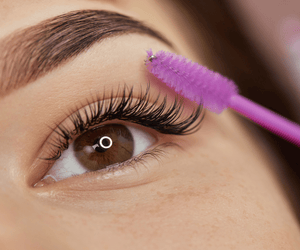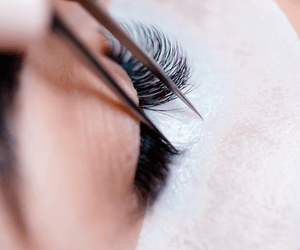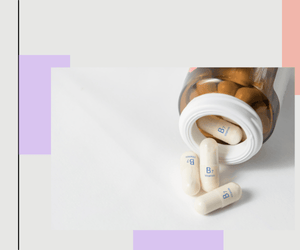
Sometimes they look so natural and hair-like, while other times they’re more gleaming and glamorous… What are eyelash extensions made of, exactly?
In the early days, falsies and lash extensions were made of organic materials, especially human and animal hair. Today, the majority of brands use a synthetic, vegan material called polybutylene terephthalate, which we more frequently refer to as PBT.
In this post, we’ll cover everything you need to know about lash extension materials, including what’s behind the terms ‘mink’ and ‘silk’, and how you can pick the best extensions for you!
Table of Contents
Main Types of Eyelash Extension Materials
These are the most common types of lash extension materials and the main things you should know about them.
PBT
The most common lash extension material is PBT or polybutylene terephthalate. It’s a versatile thermoplastic that can be stretched and molded in endless ways, and that remains durable no matter how it is shaped. It’s used for everything from computer keyboards to toothbrushes, as well as for lash extensions.
Depending on how the PBT fibers are manufactured, they can have different finishes and tapers that can mimic different organic materials, such as silk and mink. PBT is extremely popular these days because it replicates natural lashes incredibly well and doesn’t require animal-derived hair.
Mink
Today, real mink fur is sometimes used as a material for false lashes but practically never for lash extensions. In most cases, the term “mink lash extensions” is actually referring to PBT lash extensions designed to look soft and fluffy.
Faux mink lashes usually have a matte or demi-matte finish, which contributes to their soft appearance. Depending on the brand, they may have a longer or shorter taper.
In the case of mink false eyelashes, the lash fibers are truly made of shaved or brushed-off mink fur. The mink is a species of mammal related to weasels and otters. It has a soft, delicate fur that mimics natural lashes quite well. As a material, real mink looks very natural and soft, but it’s not as effective at holding a curl.
There are also significant ethical concerns about how mink fur is sourced and whether the animals come to any harm. While brands often claim that their mink fur is ethically sourced and cruelty-free, they often don’t provide much additional information or evidence, and the lack of transparency is concerning.
Silk
As with mink, silk eyelash extensions are also usually made of PBT. In the same way that most satin nowadays is made of polyester or rayon, brands use terms like “vegan silk” or “synthetic silk” to describe their PBT lashes.
In the case of silk PBT lashes, the fibers have a bit of reflective sheen, which creates the illusion that they’re a little glossy. They’re fantastic if you prefer a more glamorous look. Some brands produce silk lash extensions that have a longer taper for a softer, fluffier look, while others create them with a thicker taper for a more defined look.
Some false lash brands claim that their lashes are made of 100% real silk, implying that their lash fibers are produced from the thread spun from the cocoons of silk works. More often than not, those brands are still using synthetic silk (especially if advertising as vegan-friendly), since real silk would not be able to hold a curl.
Human Hair
Human hair is never used for eyelash extensions, but it may be used for false lashes. While you would expect human hair to look very natural, that’s actually not the case. While human hair lashes can look very wispy, they’re often thicker than natural human lashes would be and lack the tapered tip that gives natural lashes their softness.
Comparison of Different Materials
|
Material |
Used |
Source |
Finish |
Curl retention |
Ethical concerns |
|
PBT |
Very common in extensions & false lashes |
Synthetic |
Variable (can mimic silk or mink) |
Good |
None |
|
Mink |
Sometimes in false lashes |
Animals (mink) |
Soft, matte |
Poor |
High (potential for animal cruelty) |
|
Faux-Mink |
Common in false lashes & extensions |
Synthetic (PBT) |
Soft, matte |
Good |
None |
|
Faux-Silk (Real silk is not used) |
Common in false lashes & extensions |
Synthetic (PBT) |
Satin sheen |
Good |
None |
|
Human Hair |
Sometimes, in false lashes |
Human |
Natural |
Poor |
Low (depends on source) |
What Are DIY Lash Extensions Made Of?
At Lilac St., we create easy-to-apply lash extensions that are designed for home use! They offer the versatility and multi-day wear of professional lash extensions and the ease of use of false lashes.
Our DIY lash extensions are made of a type of PBT also known as Korean silk or vegan silk. The fibers have the slight sheen of silk, which lends a glamorous look to the eyes. That said, the sheen isn’t excessive, so they’re still a soft and versatile option.
The vegan silk fibers are shaped into fluttery, spiky, or full clusters by hand, and attached to an ultra-thin cotton band that’s invisible upon application.
Each set comes with five extension segments per eye, for a quick and easy application. They can stay for several days when you use our beginner-friendly Lilac Lash Glue, and for over a week when using our Pro Lash Glue. Our DIY lash adhesives are acrylate-based, gentle, and safe for sensitive eyes.
Manufacturing Process of Eyelash Extensions
The way eyelash extensions are made is fascinating. The production process is the main factor that drives how they look and feel since most lash extensions on the market are made of the same synthetic material, PBT.
The PBT first starts as pellets, which are then heated and stretched into long fibers. The ultra-long fibers are trimmed into bundles. These bundles are then organized by hand, with the help of special measuring equipment, attached to an adhesive strip, and then trimmed to a specific length while retaining their tapered edge. Finally, the extension fibers are carefully placed into packs that are then sold to salons and beauty retailers.
Beyond Materials: Additional Factors
Aside from materials, here are the other factors you should consider when getting professional lash extensions.
Final Thoughts
Thanks to its versatility and cruelty-free nature, the synthetic polymer PBT is easily the best material for lash extensions. It can be shaped and cut in many different ways, allowing lash artists to create a lot of different lash extension looks. Even for our own DIY lash extensions, vegan silk made of PBT guarantees the perfect balance of flutteriness and subtle sheen.








